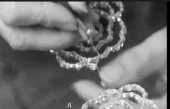“I wanted to be an Architect” Dior
French designer Christian Dior craved an artistic life as the economic world collapsed under the weight of the war machine that had eaten into Europe. He fell into the company of artists, and sought the bohemian path in the aftermath of terror. They had new hope, a brighter path, where he could be an artist or an architect and became a Fashion Designer.
Dior learnt the sophistication of simplicity through his training with designer Robert Piguet from 1937, yet his spatial designs grew out of his visual comprehension of Architecture, creating elaborate folds and abundant material to create contrasts that would highlight a slim waistline through his A-line skirts that dropped just short of the floor to make the model appear taller.
“I drew flower ladies” Dior
This return to the former traditions and the excessive indulgence of fabric angered the post-war women that had achieved a degree of independence through taking on jobs during the war that required a higher hemline and sensible attire. Material was still rationed and his designs also mocked the practice accessibility of the ‘new look’.
“The women were very closely tailored and it wasn’t easy, there was no freedom, morally women were veering toward a freer , more equal way of being, of course 68′ proved this many years later. Dior was fastening them into inconvenience with skirts like the BON BON dress that must have used 30 meters of fabric. It was tailored to the waist……tight fitting shoulders..breasts lifted with bra and corset, the dress even had an inner frame” Pierre Cardin
Dior’s vision was a cog that sent women back to the home, as the men returned from war and re-entered the workforce. Fashion that ornamented womens figures, new kitchens and pushing prams was the road into the 1950’s. Celebrities, Royalty and Movie stars modelled his frocks and set the scene in womens magazines for women to admire and sew.
Dior designed all of the dresses worn by Marlene Dietrich in Alfred Hitchcock’s classic ‘Stagefright’.
“So long as I have the dress I am the one who decides how long this show will run, .. and everything else ” (quote from movie Stagefright)
Dior did not enjoy the celebrity life, he preferred life outside of the spotlight of his Haute Couture kingdom, however his business acumen rarely failed him. Despite his success, he didn’t have a Fashion House until he was 42 years of age.
‘Australian women were among the first outside of Paris to witness, model and purchase original Dior designs. Less than a week after Dior’s dramatic debut of February 1947, articles celebrating his talent appeared in local newspapers.’ NGV
Up until the late 70’s most women could sew clothes for their families and magazines promoted dress patterns over shop purchases. Fashion designers had to be a step ahead of their acute audience and the dazzle of Dior’s complex silhouettes continued to challenge women who tried to make what few could afford. David Jones (Sydney) presented a Dior fashion parade in 1948.
The elegant French designs were tempered into frocks that marked ‘the look’ of the 50’s. As fashion relaxed in the 70’s, puffed up in the 80’s and went grunge in the 90’s, the Dior sophistication excites a retrospective desire for elegance.
During the week the NGV was wall to wall with women visiting the gallery, marking the Spring Carnival of fashion in Melbourne.
Christian Dior The Man behind the myth, Phillipe Lanfranch













